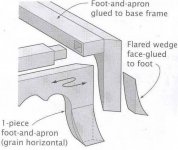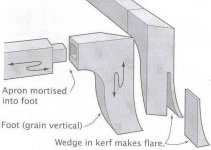I'm not familiar with Carlyle Lynch's method, so what I'm about to write may be a method your friend has already rejected. Also, though there is probably not universal agreement about the terminology, I'm following Charles Hayward's distinction between "French feet" and "French bracket feet." My response assumes your friend is asking about the former.
On higher style pieces with French feet, one method was to cut recesses into the material at the lower end of the feet to receive blocks of wood large enough to allow the outward curves to be shaped. Then after the feet were shaped, everything was veneered over.
More "vernacular" pieces, at least here in the U.S., were sometimes built in the solid (i.e., without veneering), which presents a relatively unique construction challenge. Typically, the grain on the ends of the carcass ran all the way to the ground, so there was no straightforward way to provide the extra thickness of material for the outwardly curved feet without a lot of waste. And simply gluing blocks into recesses, as with the veneered pieces, was apparently considered to be unsightly. One way to deal with this was to saw a kerf part way up each leg, parallel with the face of the carcass end piece. The idea was to place the kerf close enough to the face that the remaining face material would be thin enough to be flexible yet thick enough to have some integrity. Then a curved "shim" was gently worked up into the kerf and glued in place. Needless to say, there was/is some danger of breaking off the "face flap," which can been mitigated by wetting it.
The skirt of the front can then be faced with vertical grain stuff, with thicker facing at the legs to provide material for the outward curves. They also need to be extra wide to cover the laterally curved portion of the foot in the carcass end piece.
If your friend is actually asking about French bracket feet, then a different method will be in order.
Don McConnell
Eureka Springs, AR


